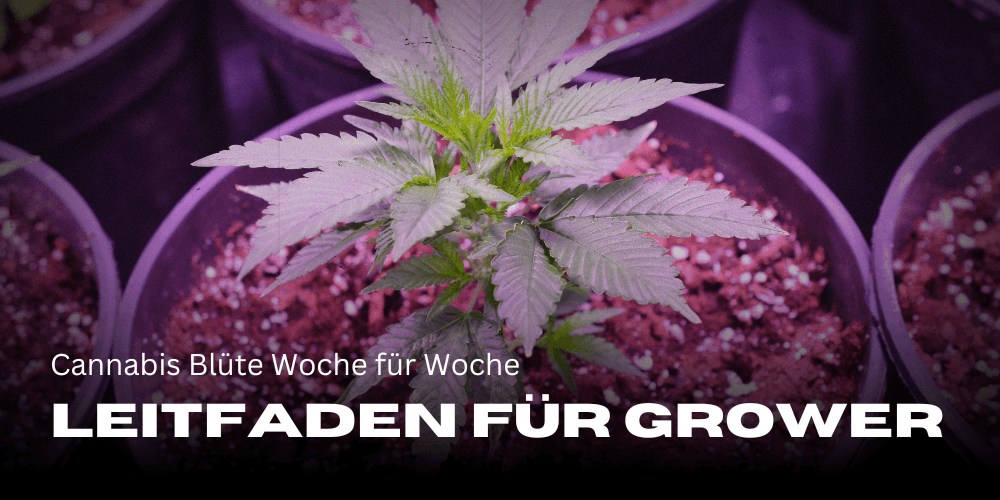Cannabis flowering week by week: a guide for growers

Inhaltsverzeichnis: Cannabis flowering week by week: a guide for growers
- Week 1 of flowering: the transition from the growth to the flowering phase
- Week 2 of flowering: First flower buds and stigmas
- Week 3 of flowering: the growth of the flowers
- Week 4 of flowering: flower development and resin production
- Week 5 of flowering: maximum flower formation
- Week 6 of flowering: trichomes and ripening
- Week 7 of flowering: ripening and preparing for harvest
- Week 8 of flowering: harvest time - how to do everything right
- Conclusion: Successful cannabis flowering phase
The flowering phase is one of the most exciting and important phases in cannabis cultivation. After weeks of vegetative growth, it's finally time to get down to business: the plant develops flowers that are later harvested and processed. The flowering phase usually lasts 8 to 10 weeks - this can vary slightly depending on the strain. In this guide, I will explain week by week what you need to pay attention to during the flowering phase, how the plant develops and how you can maximize the yield.
Week 1 of flowering: the transition from the growth to the flowering phase
In the first week of flowering, you will notice how your cannabis plant slowly flips the switch. It recognizes that the light cycles are getting shorter (typically 12 hours of light, 12 hours of darkness) and reacts to this. During this transition phase, the plant begins to redirect its energy from the vegetative to the flowering phase. You will notice that stigmas - small, white hairs - begin to form on the nodes (the places where the leaves branch out).
Here it is important that you:
- Adjust the light cycle to 12/12.
- Continue to fertilize the plant with a slightly reduced amount of nitrogen, but increase the amount of phosphorus and potassium.
Week 2 of flowering: First flower buds and stigmas
In the second week, the inflorescences become increasingly visible. The plant now invests all its energy in flower formation, which means that vegetative growth comes to a standstill. The stigmas on the nodes become more numerous and longer. These are the first visible indication that the plant is female and developing flowers.
Important points in week 2:
- Make sure you provide the plant with enough nutrients, especially phosphorus and potassium.
- Monitor the humidity, as too much humidity can promote the formation of mold.

Week 3 of flowering: the growth of the flowers
In week 3, flower formation really picks up speed. You will see that the flowers are now growing faster and small buds are developing. During this phase, it is crucial to keep a close eye on the environmental conditions. The plant needs plenty of light and sufficient nutrients to support growth.
Important care instructions:
- Provide sufficient light, at least 600W (for HPS lamps) or equivalent for LEDs.
- Continue to give the plant special flowering fertilizers with a high phosphorus content.
- Good aeration helps to keep the flowers healthy.
Week 4 of flowering: flower development and resin production
Now it gets exciting: in week 4, the plant begins to produce resin. Resin contains the valuable cannabinoids such as THC and CBD that give cannabis plants their psychoactive and medicinal properties. The flowers continue to swell and the stigmas slowly begin to curl.
In week 4, you should pay attention:
- This is a good time to pay attention to the quality of the resin. Trichomes will become visible, which are crucial for potency later on.
- Make sure the plant is getting enough potassium, as this supports flower formation.
- Keep the humidity low (around 40-50%) to prevent mold.
Week 5 of flowering: maximum flower formation
The flowers have reached their full size in week 5. The smell becomes more intense and the flowers begin to thicken. This is the phase when your plant needs the most nutrients to support growth and fill the trichomes.
Important points in week 5:
- If you are growing indoors, a charcoal filter might be useful as the odor of the buds increases greatly now.
- Stick to the nutrient schedule consistently, as the plant consumes a lot of energy during this phase.

Week 6 of flowering: trichomes and ripening
In week 6, you can take a closer look at the trichomes. These small crystal-like glands on the flowers are an indication of how close the plant is to maturity. Trichomes begin to turn from clear to milky - a sign that the plant will soon be ready to harvest.
What to do:
- Use a magnifying glass or microscope to check the condition of the trichomes.
- Gradually reduce the nutrients and prepare the plant for flushing.
Week 7 of flowering: ripening and preparing for harvest
In the penultimate week of the flowering phase, the focus is on ripening the flowers. The trichomes should now be predominantly milky, which indicates the optimum THC content. It is time to prepare the plant for harvest.
Important steps in week 7:
- Stop feeding nutrients and rinse the plant with clear water to remove fertilizer residue.
- Watch for the stigmas to start turning from white to brown.
Week 8 of flowering: harvest time - how to do everything right
Week 8 marks the end of the flowering phase and nothing stands in the way of harvesting. The trichomes should now be milky to amber in color - a sign that the plant has reached its peak.
Harvesting tips:
- Harvest the plant when about 70-80% of the trichomes are milky.
- Cut the plant, hang it upside down and leave it to dry in a dark, well-ventilated room.
Conclusion: Successful cannabis flowering phase
The cannabis flowering phase is an exciting and critical time for every grower. By observing the development of the plant week by week and making appropriate adjustments to care, you can ensure that your plants develop their full potential. Patience, good observation skills and proper care are the keys to a successful harvest.
















